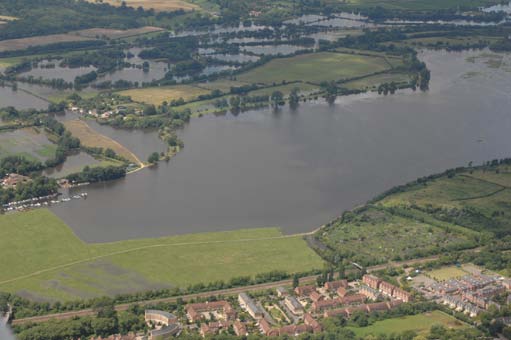Floodplains are active and dynamic environments. They are important zones through which groundwater moves in and out of rivers and streams.
Floodplains potentially play a key role in attenuating dissolved contaminants, particularly as they increasingly define a limit to urban expansion, forming a boundary zone between urban and rural areas. BGS investigated how the biogeochemical processes operating in floodplain environments might affect the concentrations of groundwater contaminants from urban environments reaching surface water courses.

Port Meadow in flood during July 2007. BGS © UKRI.
Our field observatory
Port Meadow lies to the north-west of the city of Oxford; it is grazed by horses and cattle. Groundwater flows across the meadow from the urban area in the east towards the River Thames in the west. It is prone to flooding and features an area of standing water for much of the year. Its chemistry is also affected by the presence of an old domestic waste dump on its eastern side.
Floodplain processes
Floodplain sediments are typically low-oxygen environments and this is reflected in the groundwater chemistry, for example low nitrate and high iron (Fe) and manganese (Mn).
Sampling techniques
Samples were collected from a number of boreholes across the study area every two months over a year, to see how chemistry varied spatially and with time as water levels changed. We also installed a new transect of nested piezometers to get a better understanding of changes in chemistry with depth and lithology.
We measured:
- inorganic chemistry
- dissolved organic carbon
- phosphorus species
- nitrogen species
- fluorescence
We also used groundwater tracer and dating techniques such as CFCs, sulfur hexafluoride and stable isotopes.
Applying all of these techniques improved our understanding of the sources of these substances (natural and anthropogenic), the geochemical processes that were occurring and the residence time of the groundwater in this complex, dynamic system.
Results so far
- The old domestic waste dump had a strong influence on the groundwater chemistry downgradient, including high specific electrical conductance, dissolved organic carbon, sodium, chloride and alkalinity
- Reducing conditions (low dissolved oxygen, low nitrate and high Fe and Mn) were prevalent across the floodplain, although fluctuations with time and water level were seen
- Residence time indicators suggested areas of preferential flow and an additional source of CFCs
- The River Thames appears to be stripping contaminants from the groundwater, even though it appears to be poorly hydraulically connected
Improving our understanding
- Further sampling: we mostly sampled during high water level conditions
- Application of novel techniques: nanoparticles, nitrous oxide and noble gas sampling would us better understand provenance and processes
- Near-surface geophysics: this could help to characterise lithological variations and preferential flow pathways
- Particle size-analysis and polyaromatic hydrocarbons: to study rates of sedimentation
Contact
Please contact Dan Lapworth for more information.
